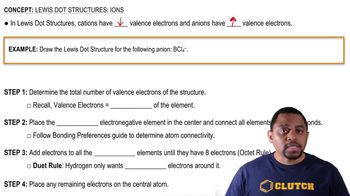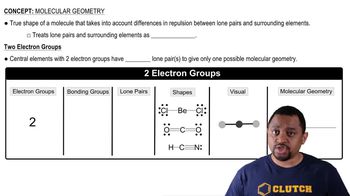Here are the essential concepts you must grasp in order to answer the question correctly.
Lewis Structure
A Lewis structure is a diagram that represents the bonding between atoms in a molecule and the lone pairs of electrons that may exist. It uses dots to represent electrons and lines to represent bonds, helping to visualize the arrangement of atoms and the distribution of electrons. Understanding how to draw Lewis structures is essential for predicting molecular geometry and reactivity.
Recommended video:
Lewis Dot Structures: Ions (Simplified) Concept 1
Octet Rule
The octet rule is a chemical guideline that states atoms tend to bond in such a way that they each have eight electrons in their valence shell, achieving a stable electron configuration similar to that of noble gases. However, some molecules, like BeCl₂, do not follow this rule, as beryllium can be stable with fewer than eight electrons. Recognizing exceptions to the octet rule is crucial for accurately representing certain molecules.
Recommended video:
Ions and the Octet Rule Concept 1
Molecular Geometry
Molecular geometry refers to the three-dimensional arrangement of atoms within a molecule. It is influenced by the number of bonding pairs and lone pairs of electrons around the central atom, which can affect the molecule's shape and properties. Understanding molecular geometry is important for predicting how molecules will interact with each other and their reactivity in chemical reactions.
Recommended video:
Molecular Geometry (Simplified) Concept 1
 Verified step by step guidance
Verified step by step guidance Verified video answer for a similar problem:
Verified video answer for a similar problem:



 0:52m
0:52m